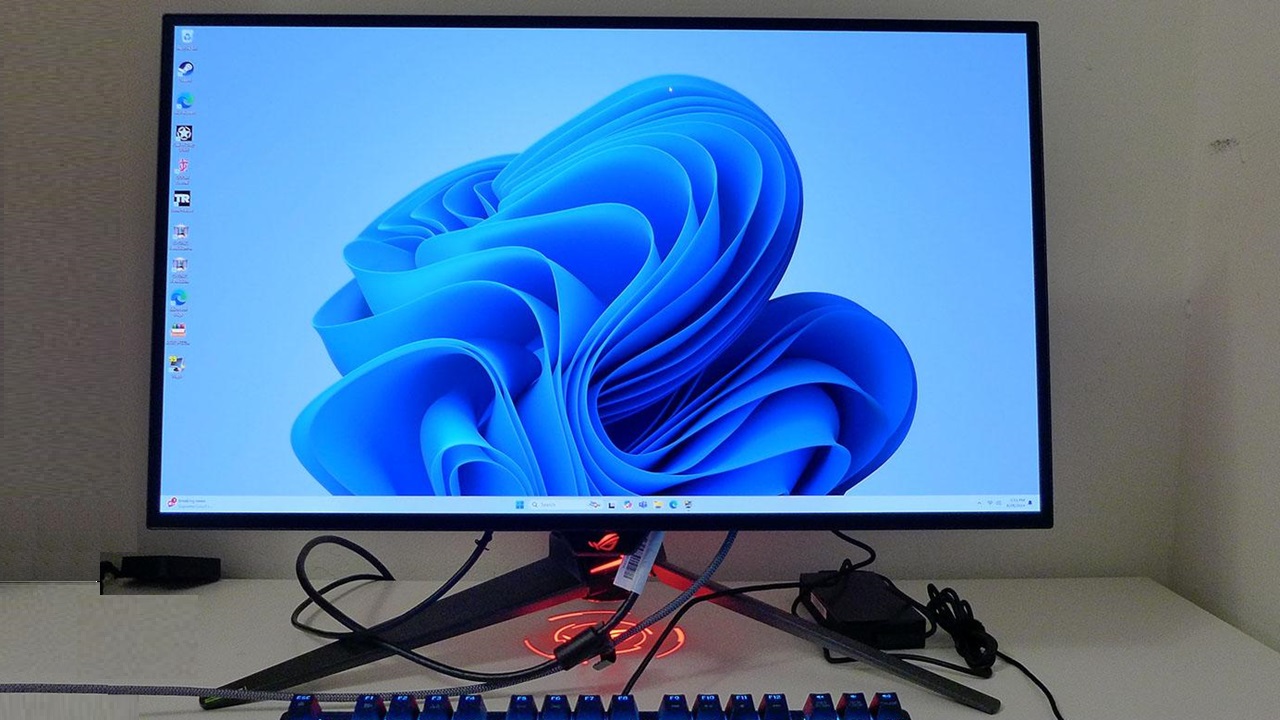
I’ve written at length about the virtues of OLED gaming monitors and how their video processing makes more of a given refresh rate than an LCD. 240 Hz OLEDs deliver smoother response and higher motion resolution than LCDs running at 360 and 500 Hz.
One would think that 240 Hz would be enough, but there is never an end to how fast we can go. A 480 Hz OLED just landed on my test bench. Asus’ latest ROG Swift offering, the PG27AQDP is a 27-inch QHD OLED with an honest and reliable 480 Hz refresh rate, Adaptive-Sync, ELMB, HDR and wide gamut color. And that 480 Hz is at the full 2560x1440 QHD resolution.
Asus ROG Swift PG27AQDP Specs
The PG27AQDP is, at this writing, the fastest QHD OLED available. The 480 Hz refresh rate is not an overclock, nor does it require a reduction in resolution. It will run at its full speed, with Adaptive-Sync and with HDR, over a DisplayPort 1.4 input, or through its two HDMI 2.1 ports. In addition to G-Sync and FreeSync certification, it will run VRR at 120 Hz with console gaming systems. You also get ELMB (Extreme Low Motion Blur) for systems running at lower frame rates. It works at either 120 or 240 Hz.
The image is typical OLED, which is to say, stunning. Though it doesn’t have a Quantum Dot layer to extend color, the gamut covers over 97% of DCI-P3 so there is plenty of rich saturation for both SDR and HDR content. Out-of-box accuracy is very good, especially in the sRGB picture mode. In addition, the PG27AQDP can be calibrated to a very high standard.
OLED, as a technology, isn’t as bright as Mini LED, but the PG27AQDP stretches the boundaries a bit with a measured 400-nit peak for SDR and HDR highlights that can touch 1,300 nits. I measured a 25% window as usual and got 709 nits, among the brightest of the OLEDs I’ve tested. With unmeasurable black levels, the PG27AQDP’s contrast is as broad as it gets. Asus has included its Uniform Brightness feature if you prefer a constant light level.
The feature list is a lengthy one. There’s a huge OSD with every option imaginable. It can be controlled by a handy joystick or by Asus’ DisplayWidget Center app. HDR content can be viewed in multiple picture modes with adjustable image controls. Operating temps are kept in check with a special heatsink. The screen care options are extensive with pixel shift, logo brightness control and conditioning routines. And special attention is paid to text clarity with Clear Pixel Edge. It reduces color fringing for a cleaner rendering of black text on light backgrounds.
Gaming aids include the full suite of Asus’ GamePlus options like sniper modes, aiming points, timers and frame counters. Some of these employ AI to make the features dynamic like crosshairs that change color and automatic shadow boost control.
Asus ROG lighting is on full display as well, with a logo projector for the desktop and a large backlit ROG logo on the back. You can specify different colors and effects, and coordinate the light show with on-screen content. USB 3.2 ports provide a convenient place to plug in controllers and peripherals. The PG27AQDP has just about everything a gamer could need or want, and it promises truly next-level performance.
Assembly and Accessories
The PG27AQDP ships with a nice bundle of extras in typical ROG fashion. A zippered pouch reveals extra lenses for the logo projector, HDMI, DisplayPort and USB cables, and an external power supply. If you want to use an arm or wall mount, there is a stout bracket adaptor. And it’s all securely packed in molded cardboard and spongy foam, not the crumbly stuff. You even get a cleaning cloth and a calibration data sheet unique to each sample.
Product 360




The PG27AQDP’s front view is all-screen with a barely visible flush bezel that’s just 9-12mm wide. A protrusion at the bottom center has a backlit ROG logo with two buttons and a joystick around the back. The side view shows the very thin OLED screen attached to a component bulge that is semi-transparent. If you look closely under bright light, you can see the internals. The ROG mantra “For those who dare” is also on full display.
The stand is very high quality with a rock-solid stance, wide deep base and smooth adjustment. There is 5/20 degrees tilt, 30 degrees swivel and a 90-degree portrait mode. The height range is 4.7 inches (110mm). Atop the upright is a threaded mount for things like webcams or microphones. The word “Swift” is backlit on the moving part of the stand. Also receiving the LED treatment is the base, ROG projector and a large ROG logo on the back. All the lighting can be controlled in the OSD with fixed or dynamic effects. Or you can turn it all off if you like.
The input panel is up and under and includes one DisplayPort 1.4 and two HDMI 2.1. All inputs can process the full QHD 480 Hz signal with HDR. The HDMI ports support 120 Hz and VRR for consoles. The DisplayPort has DSC (Display Stream Compression) which helps maintain high frame rates. Peripheral support includes USB 3.2, one upstream and two down. You get a 3.5mm headphone jack for audio but no internal speakers.
OSD Features
Pressing the PG27AQDP’s joystick opens Asus’ familiar OSD, and it is packed with features. Alternatively, you can download the DisplayWidget Center app and retain full control from the Windows desktop.



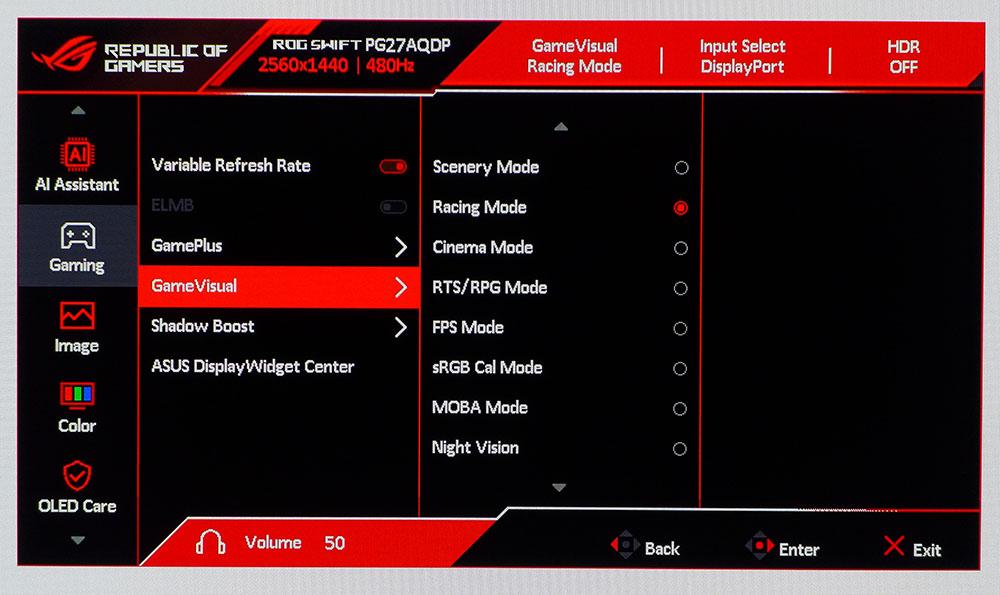

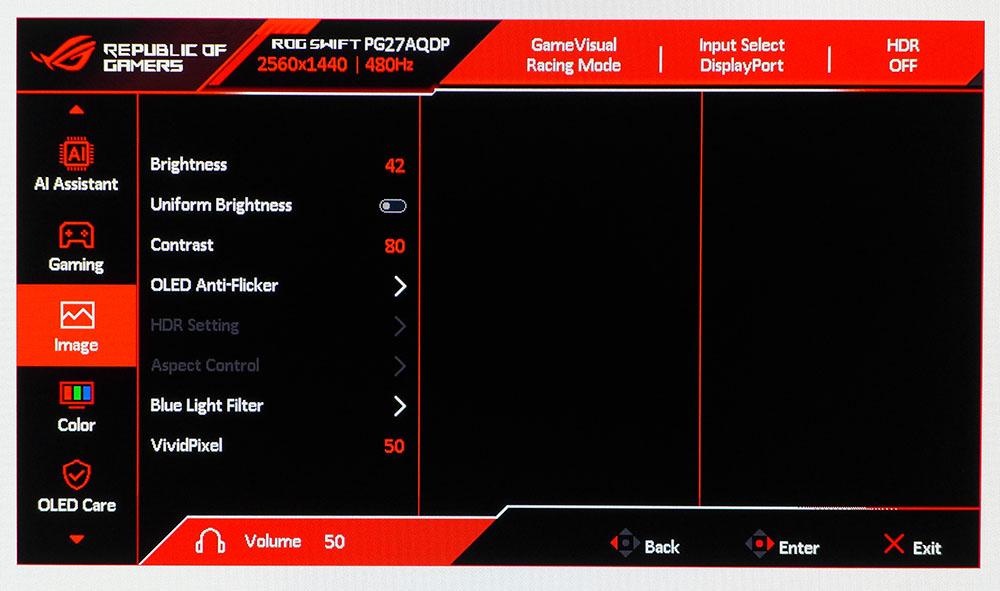





The OSD always shows signal info at the top with resolution, refresh rate, picture mode, input and HDR status. The AI Assistant has dynamic versions of popular gaming aids like aiming points, sniper mode and shadow boost. These change automatically with content to maintain contrast and visibility. MOBA Map Helper highlights the map windows usually found in shooters and RPGs.
The Gaming menu has the traditional GamePlus versions of the same play enhancements along with display alignment marks. You can also toggle Adaptive-Sync here. GameVisual is where you’ll find the nine picture modes. Racing is the default setting, and it can be calibrated to a high standard. The sRGB Cal mode is also accurate and useful when you need that smaller gamut.
The PG27AQDP’s Image menu has the traditional luminance controls along with Uniform Brightness. This is off by default, but if you want a more consistent light level, turn it on. It limits peak brightness, but it is less fatiguing during long work or gaming sessions. OLED Anti-Flicker reduces flicker sometimes seen when the refresh rate varies and has two range settings. I never saw this phenomenon during gameplay, so I left it off.
HDR content enables four additional picture modes and if you turn on Adjustable HDR, you can tweak brightness, color temp and color saturation. The brightest mode is Console HDR, while the most accurate choice is DisplayHDR 400 True Black. I’ll talk more about that on page five.
Calibration controls include fixed color temps plus RGB sliders and a range of gamma presets. You also get color saturation and color management. You can specify the color space, DCI-P3, sRGB or Native. Native covers over 97% of DCI-P3 and is useful for all SDR and HDR content.
The PG27AQDP has a huge array of OLED care options that include a screen saver, pixel cleaning routines with reminders, pixel shift and several dimming features that compensate for static objects like logos and taskbars.
The lighting is fully customizable with fixed or dynamic effects and colors. Light In Motion syncs the light show with on-screen content as long as you have a USB connection. The joystick directionals can be programmed to a variety of quick access functions like input selection or gaming aids.
Asus ROG Swift PG27AQDP Calibration Settings
In the PG27AQDP’s default Racing picture mode, the white point is slightly warm, but color and gamma are nearly spot-on. The red errors are barely visible so you can use the monitor without calibration if you like. But a reference level image can be obtained with a few tweaks of the RGB sliders in the User color temp. My recommended settings are below.
Setting brightness is different depending on whether you’ve engaged the Uniform Brightness feature. I preferred the picture with it off as it was brighter and more dynamic.
For HDR content, the PG27AQDP switches automatically and enables four additional picture modes. I liked Console HDR the best for its vivid color and high impact. To get the brightest possible image, turn on Adjustable HDR and max the brightness slider.
Gaming and Hands-on
The PG27AQDP has a large array of video processing and gameplay options. But in practice, not much tweaking is required. I set the refresh rate to 480 Hz which caused no problems at any time. With a GeForce RTX 4090 video card, I sustained frame rates around 340fps in Doom Eternal. The PG27AQDP is set for the future and likely to be fast enough for gaming systems that don’t yet exist.
If you can’t run over 200fps, the ELMB option is completely viable. It has no artifacts and only reduces brightness by around 20%. Remember that OLEDs have no overdrive so there’s no possibility of ghosting or phasing. Moving objects retain their full resolution no matter how fast the action becomes. Of course, the higher the frame rate the better. Playing over 300fps was an addictive experience. There was no perceptible input lag which meant moving and stopping was accomplished with equal precision. It’s hard to imagine a monitor that’s easier to play on.
The image was very impactful in HDR games once I engaged the Console HDR mode and upped the brightness slider to 100. Having this adjustability is a rare thing and it makes the PG27AQDP much more flexible than most HDR monitors. A Mini LED with 2,000 nits is great but if you can’t tailor it to your environment, it will tire you out. The PG27AQDP was easy on the eyes and never wore me down. You can literally lose days of time playing on this monitor.
Since Asus touts its Clear Pixel Edge technology, I put up a browser window and got out the magnifying glass. It is indeed sharper than many other monitors because it has absolutely no fringing or edging. I typically use test patterns to identify this artifact and the PG27AQDP passes them all with flying colors. This feature is worth paying extra for. The image is razor sharp and has a natural purity that many other screens lack.
The Uniform Brightness feature was handy when working in a dark room because I didn’t have to tweak the brightness slider for different ambient light levels. It’s a good solution for workday tasks because it significantly reduces fatigue, more so than a low blue light option.
Takeaway: If a 27-inch 16:9 QHD monitor is your screen format of choice, there is none better than the PG27AQDP. It does everything well and truly excels at gaming. It’s speedy, smooth and responsive, and delivers one of the best HDR images you’ll see. It’s color accurate so you can use it for pro-level tasks too. In many hours of use, I could find nothing to complain about.
MORE: Best Gaming Monitors
MORE: How We Test PC Monitors
MORE: How to Buy a PC Monitor
MORE: How to Choose the Best HDR Monitor
I’ve rounded up the latest speedy screens, including two dual-mode displays, Asus’ PG32UCDP, which has an FHD 480 Hz mode. It runs UHD natively at 240 Hz. Also here is MSI’s MPG271QRX, ViewSonic’s XG272-2K and Alienware’s AW2725DF.
Pixel Response and Input Lag
Click here to read up on our pixel response and input lag testing procedures.
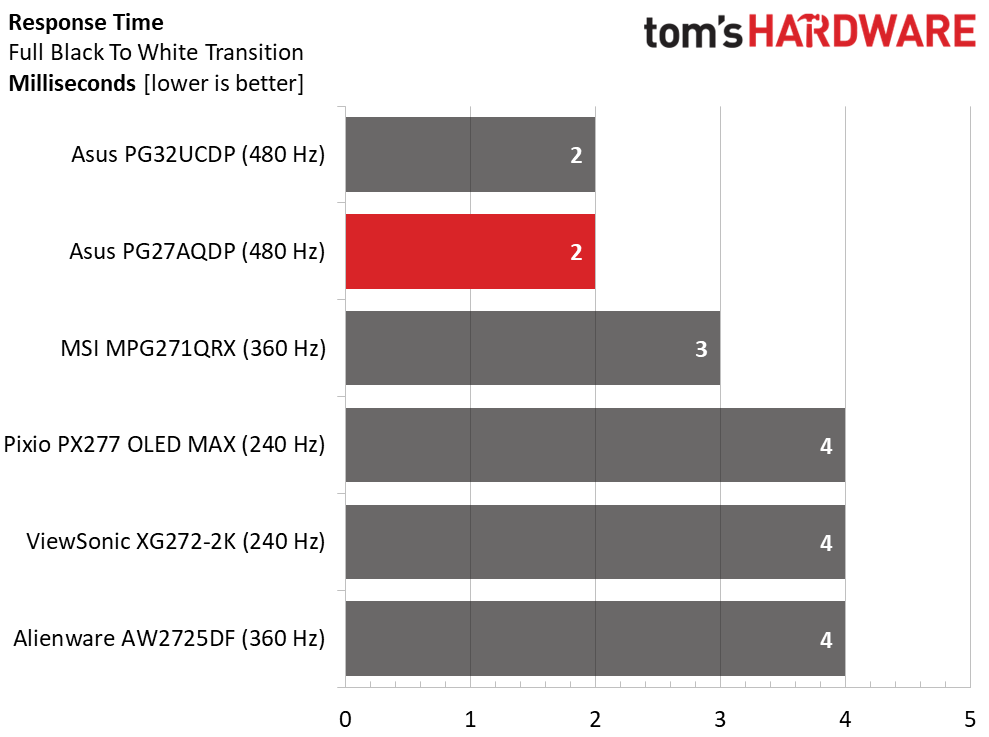
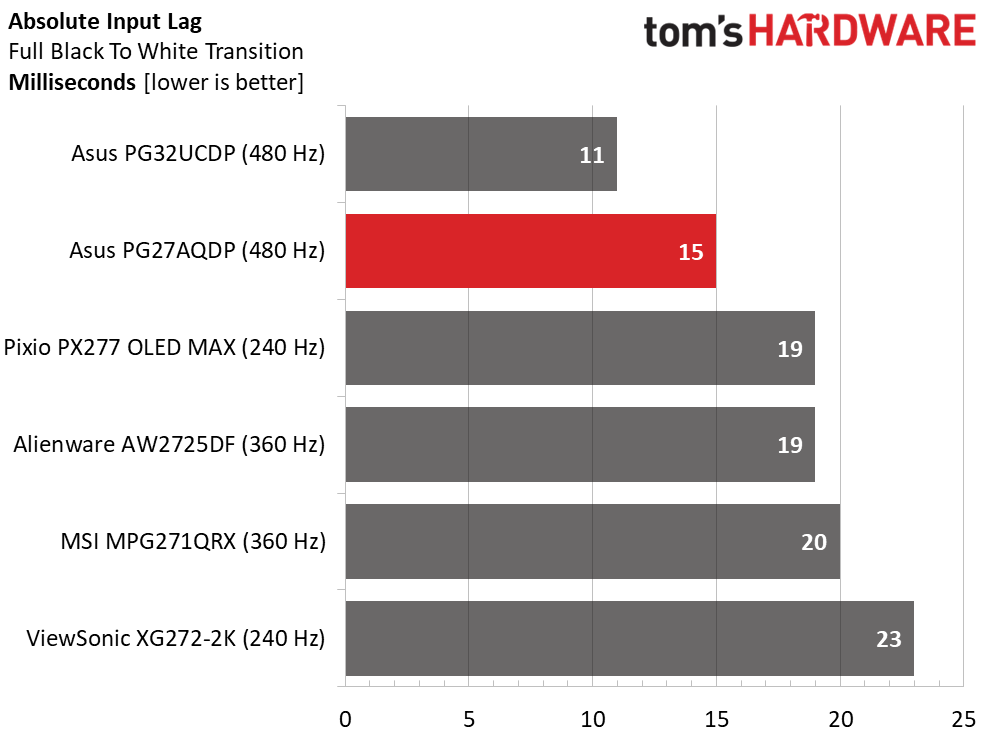
480 Hz means near-instant rendering of a full white field pattern. It takes just two milliseconds, and this is typical of any 480-540 Hz monitor. This guarantees the highest possible motion resolution. Moving objects retain the same level of detail as stationary ones.
The separator is then total input lag. The PG27AQDP has just 15ms of total lag, which isn’t quite at the record level of the PG32UCDP’s 11ms, but remember, the 27-inch display accomplishes this at QHD resolution while the 32-inch screen is running FHD. The dual-mode AW2725QF is just behind at 17ms. The others might be the bottom three, but they are also super-fast. Any gamer will be happy to play on any of these monitors.
Test Takeaway: The PG27AQDP doesn’t quite break the record but with 15ms of total control lag, it’s very close. Note that the PG32UCDP must reduce its resolution to take the win. In practice, I couldn’t hit the full 480fps when playing Doom Eternal on a GeForce RTX 4090. The average frame rate was around 340fps. But considering its OLED smoothness, QHD resolution and high pixel density, the PG27AQDP is simply amazing and must be seen to be believed.
Viewing Angles

The PG27AQDP delivers typical viewing angles for the OLED category. There is almost no difference in color or brightness between the head-on and 45-degree views. The top view is also completely usable, with only a slight drop in gamma observed. This is excellent performance. OLED is by far the best screen tech for two users to share.
Screen Uniformity
To learn how we measure screen uniformity, click here.

My PG27AQDP sample showed visually perfect screen uniformity with a deviation of just 2.4%. That’s among the lowest I’ve ever recorded. I’d say it doesn’t get better, but the Alienware AW2725DF hits 2.39%. Talk about a photo finish!
MORE: Best Gaming Monitors
MORE: How We Test PC Monitors
MORE: How to Buy a PC Monitor
MORE: How to Choose the Best HDR Monitor
To read about our monitor tests in-depth, please check out Display Testing Explained: How We Test PC Monitors. We cover brightness and contrast testing on page two.
Uncalibrated – Maximum Backlight Level

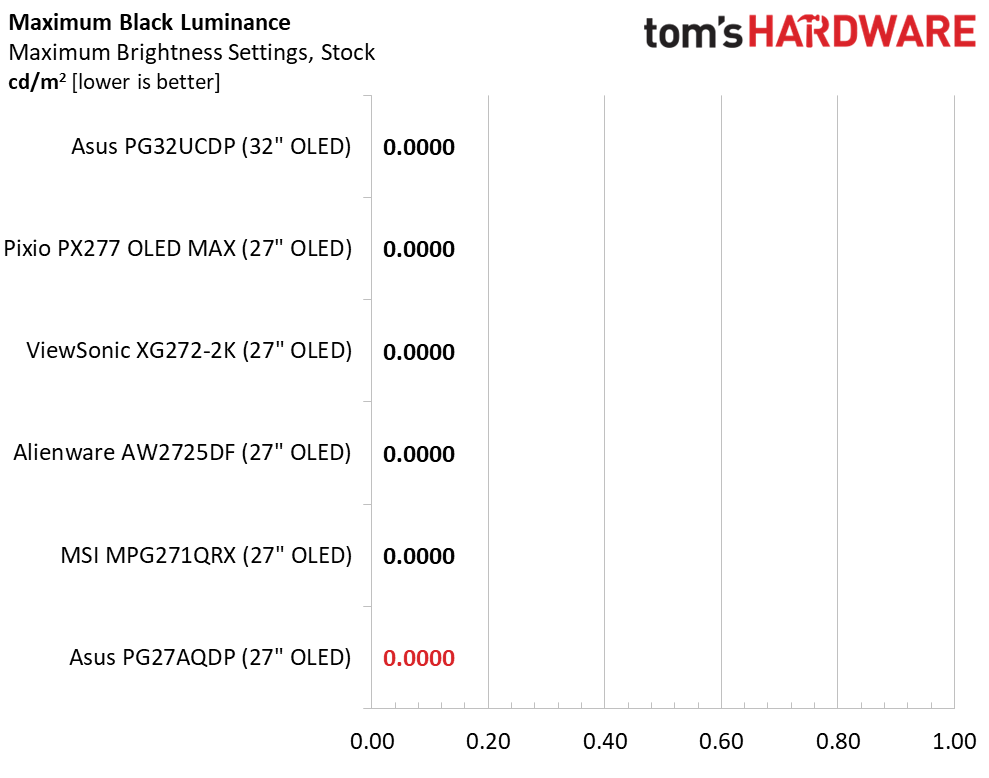

Anyone concerned about OLED’s reputation for low brightness can be assured that the PG27AQDP does not share this trait. Only a high-end Mini LED will be brighter, and this Asus has more output than many LCD monitors. I measured 25% window patterns with Uniform Brightness turned off. If you turn it on, the peak is around 260 nits. In either case, black levels and contrast are unmeasurable.
After Calibration to 200 nits

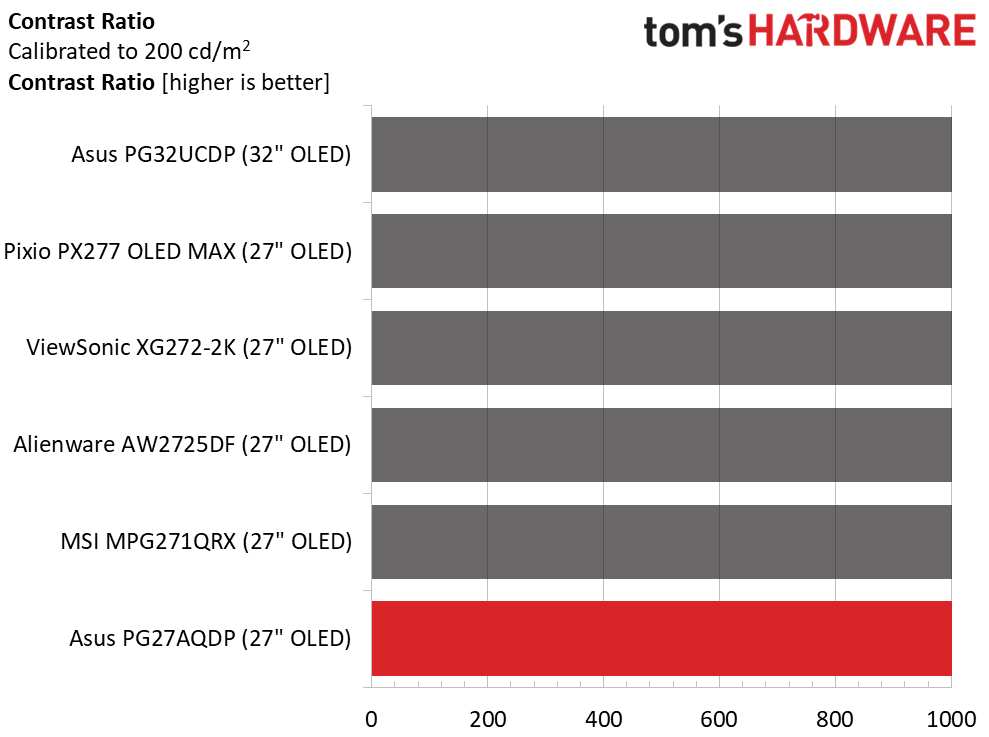
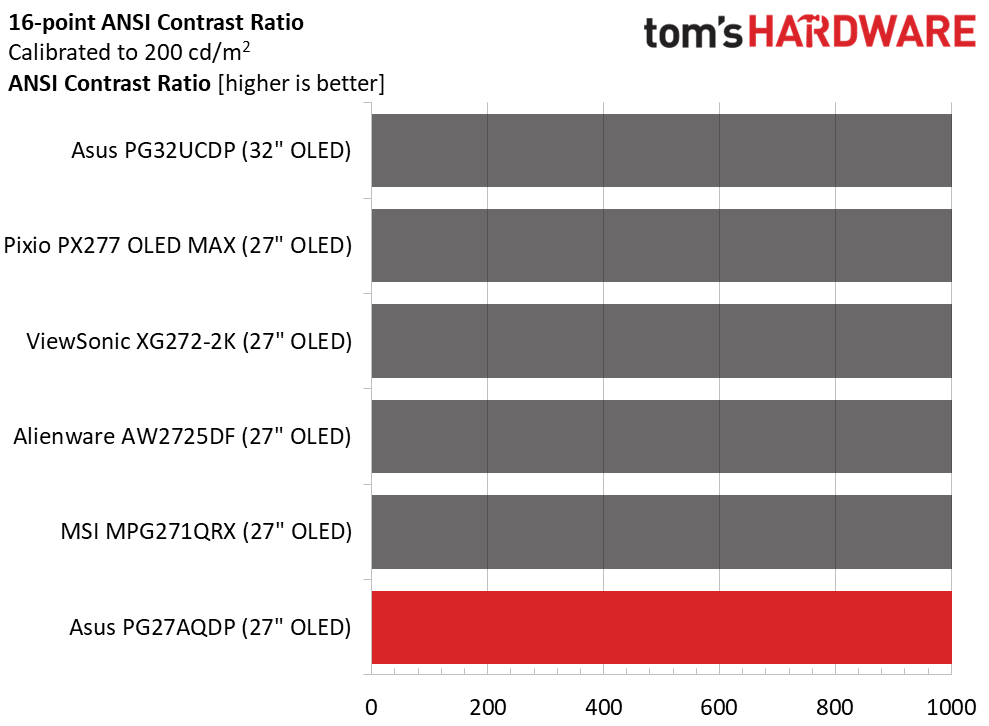
Calibration doesn’t alter the results or rankings. The PG27AQDP is one of the brighter OLEDs available, so that is a major point in favor. I couldn’t measure black levels for either test so contrast couldn’t be determined either.
Test Takeaway: It’s a given that any OLED panel will have an unmeasurable contrast due to its infinite black levels. So, if any ranking is to be undertaken, peak brightness is the only differentiator. The PG27AQDP is one of the brighter OLEDs available in any size or price category. And it has the flexibility of a Uniform Brightness option if you find it too bright.
MORE: Best Gaming Monitors
MORE: How We Test PC Monitors
MORE: How to Buy a PC Monitor
MORE: How to Choose the Best HDR Monitor
Asus ROG monitors are typically accurate out of the box, and the PG27AQDP is no exception. Though there is some room for improvement, it can be used without calibration in its Racing and sRGB modes.
Grayscale and Gamma Tracking
Our grayscale and gamma tests use Calman calibration software from Portrait Displays. We describe our grayscale and gamma tests in detail here.


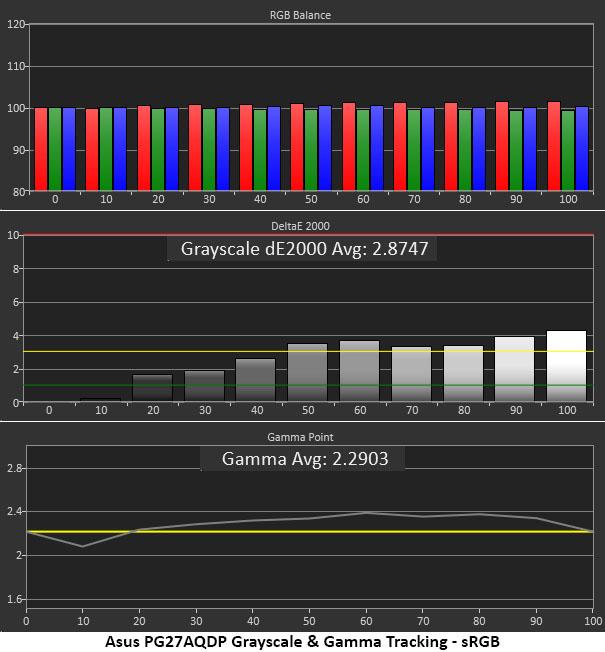
The PG27AQDP’s default grayscale run is a bit warm in tone. Red errors are visible from 40 to 100% brightness. This is forgivable because it’s harder to spot in content than green or blue issues. Gamma runs slightly dark but remains close to the 2.2 reference line throughout.
Calibration removes all visible grayscale errors and delivers pro-level accuracy. Gamma becomes slightly darker, but again, it's close to the reference line at all points, so it doesn’t impact the image in any significant way. If you want lighter gamma, choose the 2.0 preset and it will track around 2.09.
In the sRGB Cal mode, grayscale is very good with a 2.87dE average error. Gamma is a bit wonky though with a dip at 10% (too light) and a general track that’s too dark. The image is a bit less vivid than it could be, but this is still a suitable picture mode for graphics work.
Comparisons




The PG27AQDP’s default 4.35dE grayscale error seems high, but since it’s concentrated in red, it is less visible. Green and blue errors are more obvious to the naked eye. Calibration makes a substantial improvement to 0.53dE, good enough for the top spot.
Gamma tracks with a tight 0.10 range of values but is a tad dark with an actual value of 2.30, a 4.54% deviation from the 2.20 spec.
Color Gamut Accuracy
Our color gamut and volume testing use Portrait Displays’ Calman software. For details on our color gamut testing and volume calculations, click here.

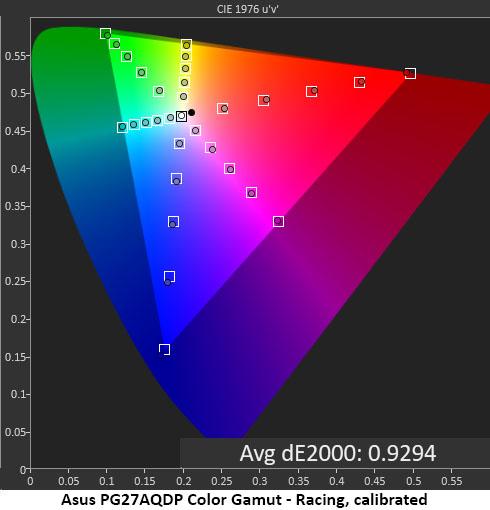

The Racing mode uses the PG27AQDP’s full native color gamut which is visually perfect when referenced to DCI-P3. With a 1.81dE average error, there is nothing to complain about. My grayscale calibration improves the value slightly to 0.93. While that is mathematically impressive, the visual difference is slight. This is excellent performance.
In the sRGB Cal mode, the PG27AQDP hits all the marks with a 2.04dE score. That is good enough for color-critical work. There are no gamma or color temp options here, but they are close enough to spec to make the PG27AQDP usable for color grading and photo editing.
Comparisons


The PG27AQDP’s color error of 0.93dE is firmly in professional territory. Only another premium Asus can do better; witness the PG32UCDP’s 0.60dE result. It doesn’t get much better than that.
In the volume test, you can see that the PG27AQDP does not employ Quantum Dot technology. The top two screens do, and they cover around 110% of DCI-P3. But the visual difference here is small. Any OLED will look more colorful than an LCD unless it too is equipped with a QD layer. The PG27AQDP hits nearly ideal volumes for both DCI-P3 and sRGB.
Test Takeaway: The PG27AQDP has exemplary color accuracy and performance. It’s more colorful than anything short of a Quantum Dot display. It can be used without calibration, but with a few tweaks, it achieves reference level. I have no complaints whatsoever.
MORE: Best Gaming Monitors
MORE: How We Test PC Monitors
MORE: How to Buy a PC Monitor
MORE: How to Choose the Best HDR Monitor
Our HDR benchmarking uses Portrait Displays’ Calman software. To learn about our HDR testing, see our breakdown of how we test PC monitors.
If you want the best possible HDR quality, an OLED monitor is the way. The PG27AQDP exemplifies this by embracing the HDR10 standard with seamless operation, four picture modes and adjustment options.
HDR Brightness and Contrast

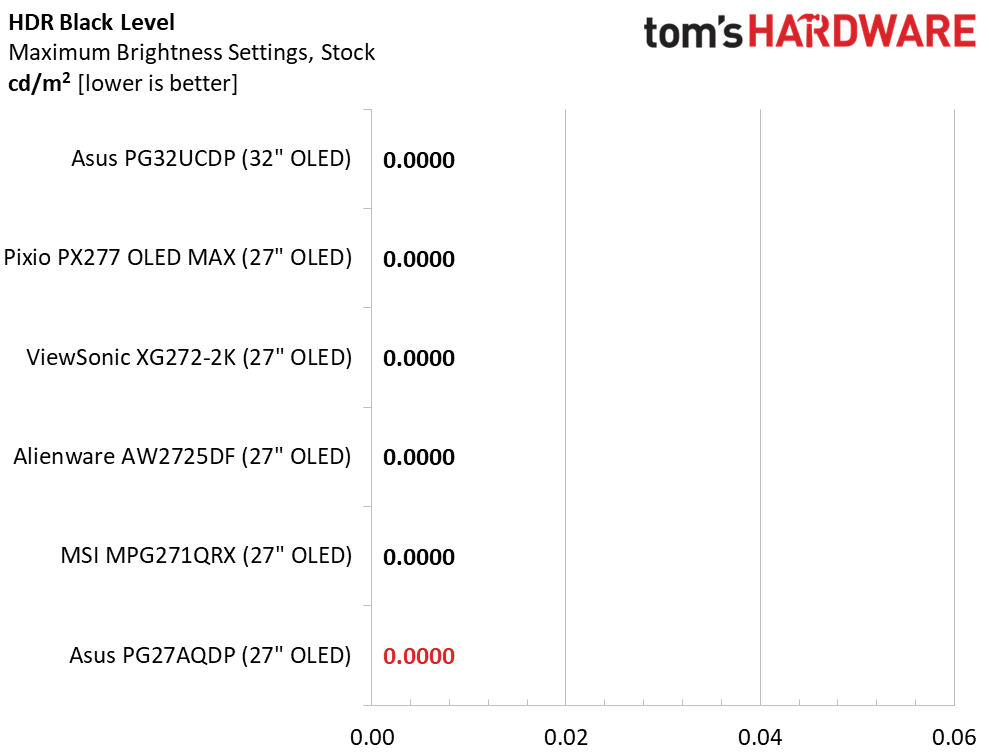
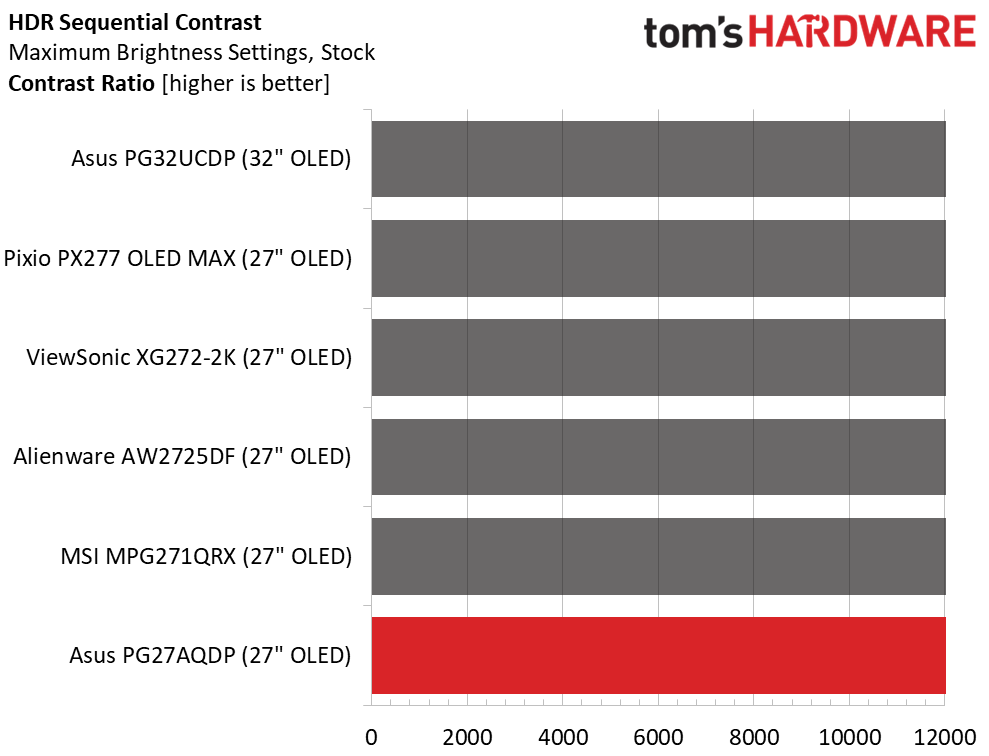
To achieve the brightest possible HDR image, I selected the Console HDR mode and maxed the brightness slider. A 25% window pattern measured over 709 nits, which is brighter than most OLEDs and many LCD monitors. Black levels and contrast cannot be measured. Only the XG272-2K and PX277 OLED MAX are brighter. The less bright Alienware and MSI monitors have the same deep blacks and broad contrast as any OLED.
Grayscale, EOTF and Color



I compared all four HDR modes to find the best compromise between brightness and accuracy. Console HDR has the highest peaks, but its EOTF is a little skewed. It’s not off enough to obscure detail and the bump between 40 and 70% gives a little more verve to mid tones. If you want the most accurate luminance tracking, choose True Black. It’s a bit darker at just 453 nits peak. Whatever the mode; color and grayscale track the same. There are no visible grayscale errors and color is slightly over-saturated. DCI-P3 is fully covered and Rec.2020 maxes out at 85% red, 70% green and 90% blue. This is the expected result given the gamut volumes I measured earlier.
Test Takeaway: The PG27AQDP offers a choice between accuracy and impact in its HDR modes. Console delivers a bright and three-dimensional picture with palpable texture. True Black has reference-level accuracy if you need to work in a creation or post-production setting. Either way, you can adjust brightness, color temp and saturation, which is something few HDR monitors offer. The PG27AQDP is one of the best HDR desktop displays available.
MORE: Best Gaming Monitors
MORE: How We Test PC Monitors
MORE: How to Buy a PC Monitor
MORE: How to Choose the Best HDR Monitor
For price-no-object gaming monitors, you now have a number of choices for the highest frame rates and lowest input lag. There is the Asus’ dual mode PG32UCDP which is super quick but sacrifices resolution to put up fast numbers. Then there are 25-inch FHD monitors running at 360, 500 and 540 Hz. There are quite a few examples, and they deliver incredible frame rates and low input lag. But they also sacrifice resolution and contrast. Lastly, there are 240 Hz OLEDs which have the best of everything. Their motion resolution is perfect, they have low input lag, and their images are stunning with deep contrast and saturated color.

The Asus ROG Swift PG27AQDP sits at the pinnacle of the premium gaming monitor category. It has an honest and reliable 480 Hz refresh rate at QHD resolution. Not only is the pixel density an ideal 109ppi, but it also has Asus’ Clear Pixel Edge tech making a visible difference in clarity. Adaptive-Sync is free of artifacts, and if you hitch it to a slower video card, ELMB retains high motion resolution at 120 and 240 Hz.

Like all the OLEDs I’ve reviewed, the image is peerless. The best Mini LED panels do a good job, but they don’t surpass OLED. The PG27AQDP’s black levels are true and dynamic range is as broad as is possible. There are some OLEDs with greater color volume, such as the Quantum Dot models, but the PG27AQDP covers over 97% of DCI-P3, which is well above the average for wide-gamut monitors.
The PG27AQDP doesn’t skimp in the feature department in any way. It has every Asus ROG add-on to aid gameplay and ensure convenient and easy use. There is nothing it cannot do well. Unless you want a larger screen, there is no better OLED gaming monitor at present than this. If you have the budget and the desire for ultimate performance, you should definitely check it out.
MORE: Best Gaming Monitors
MORE: How We Test PC Monitors
MORE: How to Buy a PC Monitor







